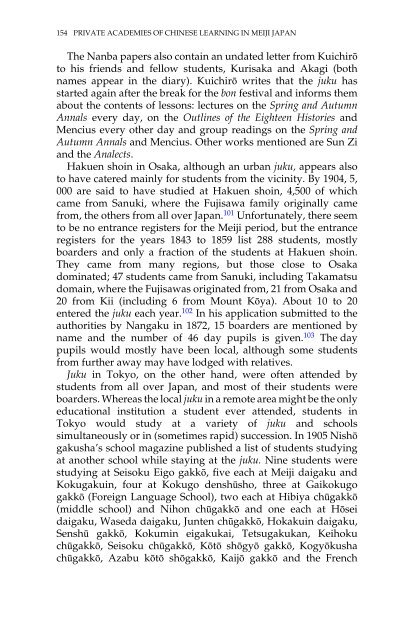Private Academies of Chinese Learning in Meiji Japan: The Decline ...
Private Academies of Chinese Learning in Meiji Japan: The Decline ...
Private Academies of Chinese Learning in Meiji Japan: The Decline ...
Create successful ePaper yourself
Turn your PDF publications into a flip-book with our unique Google optimized e-Paper software.
154 PRIVATE ACADEMIES OF CHINESE LEARNING IN MEIJI JAPAN<strong>The</strong> Nanba papers also conta<strong>in</strong> an undated letter from Kuichirōto his friends and fellow students, Kurisaka and Akagi (bothnames appear <strong>in</strong> the diary). Kuichirō writes that the juku hasstarted aga<strong>in</strong> after the break for the bon festival and <strong>in</strong>forms themabout the contents <strong>of</strong> lessons: lectures on the Spr<strong>in</strong>g and AutumnAnnals every day, on the Outl<strong>in</strong>es <strong>of</strong> the Eighteen Histories andMencius every other day and group read<strong>in</strong>gs on the Spr<strong>in</strong>g andAutumn Annals and Mencius. Other works mentioned are Sun Ziand the Analects.Hakuen sho<strong>in</strong> <strong>in</strong> Osaka, although an urban juku, appears alsoto have catered ma<strong>in</strong>ly for students from the vic<strong>in</strong>ity. By 1904, 5,000 are said to have studied at Hakuen sho<strong>in</strong>, 4,500 <strong>of</strong> whichcame from Sanuki, where the Fujisawa family orig<strong>in</strong>ally camefrom, the others from all over <strong>Japan</strong>. 101 Unfortunately, there seemto be no entrance registers for the <strong>Meiji</strong> period, but the entranceregisters for the years 1843 to 1859 list 288 students, mostlyboarders and only a fraction <strong>of</strong> the students at Hakuen sho<strong>in</strong>.<strong>The</strong>y came from many regions, but those close to Osakadom<strong>in</strong>ated; 47 students came from Sanuki, <strong>in</strong>clud<strong>in</strong>g Takamatsudoma<strong>in</strong>, where the Fujisawas orig<strong>in</strong>ated from, 21 from Osaka and20 from Kii (<strong>in</strong>clud<strong>in</strong>g 6 from Mount Kōya). About 10 to 20entered the juku each year. 102 In his application submitted to theauthorities by Nangaku <strong>in</strong> 1872, 15 boarders are mentioned byname and the number <strong>of</strong> 46 day pupils is given. 103 <strong>The</strong> daypupils would mostly have been local, although some studentsfrom further away may have lodged with relatives.Juku <strong>in</strong> Tokyo, on the other hand, were <strong>of</strong>ten attended bystudents from all over <strong>Japan</strong>, and most <strong>of</strong> their students wereboarders. Whereas the local juku <strong>in</strong> a remote area might be the onlyeducational <strong>in</strong>stitution a student ever attended, students <strong>in</strong>Tokyo would study at a variety <strong>of</strong> juku and schoolssimultaneously or <strong>in</strong> (sometimes rapid) succession. In 1905 Nishōgakusha’s school magaz<strong>in</strong>e published a list <strong>of</strong> students study<strong>in</strong>gat another school while stay<strong>in</strong>g at the juku. N<strong>in</strong>e students werestudy<strong>in</strong>g at Seisoku Eigo gakkō, five each at <strong>Meiji</strong> daigaku andKokugaku<strong>in</strong>, four at Kokugo denshūsho, three at Gaikokugogakkō (Foreign Language School), two each at Hibiya chūgakkō(middle school) and Nihon chūgakkō and one each at Hōseidaigaku, Waseda daigaku, Junten chūgakkō, Hokaku<strong>in</strong> daigaku,Senshū gakkō, Kokum<strong>in</strong> eigakukai, Tetsugakukan, Keihokuchūgakkō, Seisoku chūgakkō, Kōtō shōgyō gakkō, Kogyōkushachūgakkō, Azabu kōtō shōgakkō, Kaijō gakkō and the French













